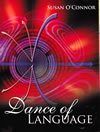Writing Short Fiction: The Path to Understanding Literature
 Writing short fiction in the secondary school classroom brings out the best in creative writing and establishes an environment
for improving communication skills, all in a venue that can be enjoyable and fulfilling. While this assertion may sound like big promises
for teachers of teenagers, I have seen the positive results of this endeavor for over twenty years. The magic of reading fiction is that
the process of producing it isn’t really magic at all but a process that evolves over time. Writing a short story, which is
what I ask my students to do, is a series of steps in which many different elements of the language come together to tell an engaging story.
In Dance of Language I explain in detail this process using specific activities that encourage the transfer of skills
to the students’ overall command of the language.
Writing short fiction in the secondary school classroom brings out the best in creative writing and establishes an environment
for improving communication skills, all in a venue that can be enjoyable and fulfilling. While this assertion may sound like big promises
for teachers of teenagers, I have seen the positive results of this endeavor for over twenty years. The magic of reading fiction is that
the process of producing it isn’t really magic at all but a process that evolves over time. Writing a short story, which is
what I ask my students to do, is a series of steps in which many different elements of the language come together to tell an engaging story.
In Dance of Language I explain in detail this process using specific activities that encourage the transfer of skills
to the students’ overall command of the language.
Students begin with a broad view of how to write a short story and look at the organization of basic plot structures. Once they are familiar with those archetypal motifs that are used over and over in stories, they learn to draw ideas from their own experiences and research in order to put the necessary details on the skeletal framework of a chosen plot structure. This is just the beginning. So many choices are made in the process of writing short fiction. Is that a transformation plot or a story of pursuit or rescue or even forbidden love? Will the plot have enough tension and how do I increase the tension? Is it clear what my main character wants or needs? Does my opening grab the reader in the first one hundred words? How is my diction? Does it show instead of just tell the reader what is happening?
 Louise Rosenblatt in Literature as Exploration wrote that students understand literature on a deeper level when they engage
in the writing of it themselves. Students who can construct a variety of plot structures more easily recognize the components of
those structures in the literature they read. This understanding extends to all of the elements they must include in the writing
of a short story—character development, setting, conflict and tension, and a number of other interesting character techniques.
The use of hamartia and paradigm shift asks the reader to sympathize with the human side of the character.
Symbolism and figurative language lend the imagery that creates more depth. No other activity I know prepares students for literary analysis
so well as writing original short stories. The added bonus is that many of these stories compete in short story writing competitions,
the most prestigious being the Scholastic writing contest in which students compete for Gold and Silver Key awards and
top portfolio cash prizes. Winners pick up their awards in a life changing ceremony in NYC’s Carnegie Hall each year.
Louise Rosenblatt in Literature as Exploration wrote that students understand literature on a deeper level when they engage
in the writing of it themselves. Students who can construct a variety of plot structures more easily recognize the components of
those structures in the literature they read. This understanding extends to all of the elements they must include in the writing
of a short story—character development, setting, conflict and tension, and a number of other interesting character techniques.
The use of hamartia and paradigm shift asks the reader to sympathize with the human side of the character.
Symbolism and figurative language lend the imagery that creates more depth. No other activity I know prepares students for literary analysis
so well as writing original short stories. The added bonus is that many of these stories compete in short story writing competitions,
the most prestigious being the Scholastic writing contest in which students compete for Gold and Silver Key awards and
top portfolio cash prizes. Winners pick up their awards in a life changing ceremony in NYC’s Carnegie Hall each year.
